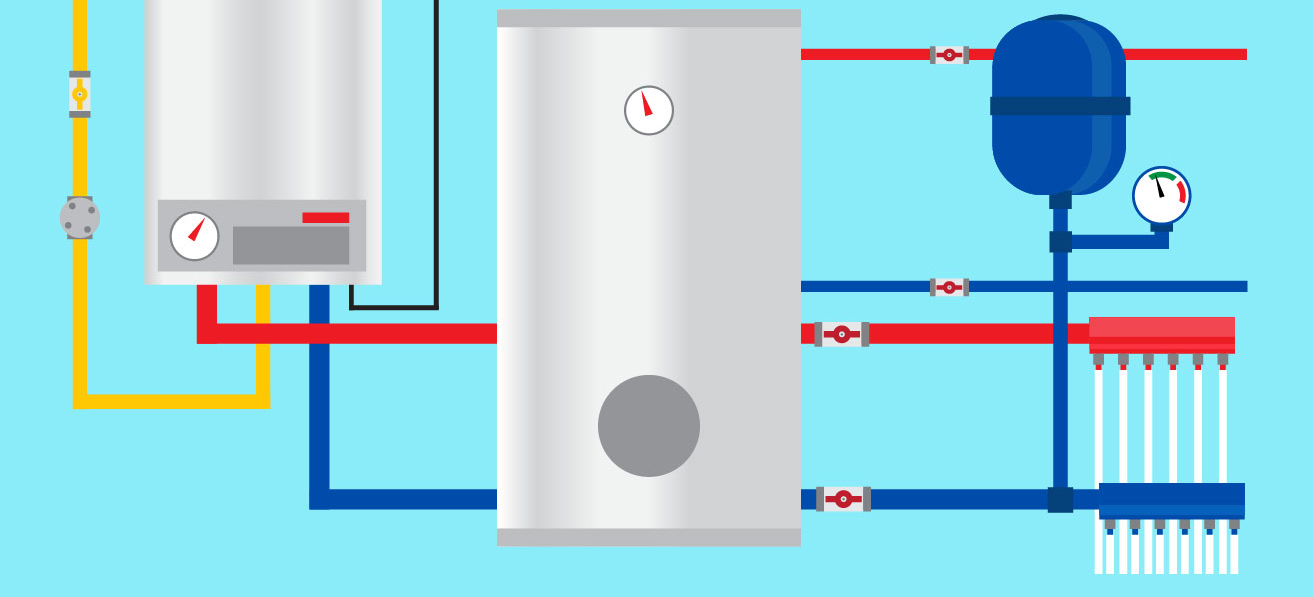How to Drain Central Heating System in 7 Easy Steps – Beginner’s Guide

As an owner of a central heating system, it should be clear to you that maintaining it regularly is essential for it to last long. Good upkeep is vital for your central heating system’s performance, and from time to time, it needs to be drained and cleaned. As there are several reasons you may do this, do you know the specific know-how on how to drain a central heating system? If not, we’ve prepared this step-by-step guide to help you out.
Table of Contents
Why Draining a Central Heating System is Necessary?
Sometimes, maintenance is not the only reason to drain your central heating. This will also be necessary when you’re up to remove a radiator, fitting a new one, or when you’re about to add an inhibitor to your system. Draining central heating, in order to remove the accumulated sludge and limescale, is also a good practice. And let’s not forget that some heating or boiler repair works can’t be dealt with without draining the whole system down.
How to Drain Central Heating System
The central heating system is an important addition to every home, as it provides hot water and heating in the property. That’s why you need to know how to handle the task properly with the following steps:
Step 1. Switch off your system
Before you start draining, switch off the system as a safety measure. Then wait until the pipes cool down completely, and if you are about to do a replacement or restoration job on your radiators, let them cool down, as well.
Step 2. Put out the solid fuel fire if there is one
If your boiler operates with solid fuel, better make sure to extinguish the fire and wait until the boiler is entirely cold.
Step 3. Cut the water supply to your boiler
Before draining the central heating system, stop the water supply to your unit, which will prevent the water from entering it while you work. There should be a separate stop tap for that; however, if there isn’t one or you find it hard to turn it, simply stop the water flow by tying up the ball valve to a wooden plank laid on top of the cistern.
Remember, there is a difference between the draining methods of conventional and combi boilers. When you want to drain a central heating system with a combi boiler, switch off the boiler, wait for it to cool down completely and proceed with the draining process. Anyway, the method you should follow with a sealed central heating system is a bit different. Firstly, isolate the water flow to the water tank and then switch the boiler off.
Step 4. Find the right radiator and drain-off valve
The right radiator, in this case, is located somewhere on the first floor of your house. Look at the bottom of the radiator, as most of the time the drain valve is located there. Grab a garden hose and clip it with the help of a clip to the outlet, so the water runs outside. The clip will prevent the hosepipe from slipping off and ending up with the water making a mess. Just in case, you can also tighten the clip with a flat-head screwdriver.
Remember, there are chemicals in the inhibitor, so locate the hosepipe somewhere away from plants and your lawn. If you don’t have a hosepipe, a bucket will also do the trick. Except you should shut off the valve every time you need to empty the bucket.
Step 5. Start bleeding your radiators
Now it’s time for the actual work. Open the bleed valve, so the water runs through the system freely. To make the water run faster, start with the radiators at the top of the building. Wait for about 15 minutes and open the bleed valves on the radiators downstairs.
Sometimes, some air gets into the system, which prevents the water from running. If so, fill the tank with about 15 cm of water and loosen the valve you previously tied up. The water should start running out of the hose in a few seconds. If that doesn’t work, then you have locked air and should join the other end of the hose to the cold tap and give a blast of water back into the radiator you are draining. Do you fear doing it wrong? My Plumber radiator service is the hassle-free alternative for “A to Z” radiator bleeding.
Step 6. Open the drain valve and discharge the water
Make sure that all the radiator valves in your house are open, and if necessary, check twice. Next, open the radiator valve to which the hosepipe is attached and drain your central heating down. Open the bleed valves of all your radiators to speed the process up.
Step 7. Refill your central heating system
Of course, once you’re done with your work, you have to refill the system. Start by closing all the valves you’ve previously opened, as well as the drain cock on the radiator. Let the water fill up the system by uniting the string in the feed tank. Once the tank is completely filled up, start bleeding the radiators downstairs. Then, repeat the latter with these upstairs and with that, your system should be filled.
We recommend that you add an inhibitor to your system to limit corrosion and limescale build-ups. Check if you’ve tightened all the valves and switch on the power supply. Wait for the system to heat and bleed the radiators once again. Check all joints and valves to ensure there are no visible radiator leaks.
How to Drain Central Heating System Without Drain Valve
Having no drain-off valve? Then, follow along:
Step 1. Turn off your system and cut the water supply
Before starting the draining process, switch off the system and wait for the pipes and radiators to cool down entirely. If you deal with a combi-boiler, turn it off, wait for it to cool and discharge the water. But if you own a conventional system, then, first, make sure to isolate the water and then turn off the boiler.
Step 2. Isolate the radiator from your heating system
When draining central heating without a drain valve, you need to separate the radiator from the system. Here, all you need to do is close the two valves. For the regulator, you need to rotate it in a clockwise direction. When it comes to the lockshield, remove the plastic cap, grab the pliers and close the valve back tightly.
Step 3. Bleed all of your radiators
Open the bleed valves to let the air out of your system, as this will speed up the process of draining.
Step 4. Loosen the union nuts and stop the leaking water
The method by which you drain a central heating system without a drain valve should look something like this:
- Release the coupling nut on the regulator side.
- Place a bucket and old rags under it and have an absorbent towel on hand.
- With the help of a spanner, rotate the nut counterclockwise until the water starts pouring into the bucket.
Step 5. Attach a hose and drain your system
When the radiator valve is in the off position, attach a hose to it and start draining your central heating system. You will need a special fitting to attach the hose itself. That can be a speed fit tap or a speed fit draining fitting. Once the radiator is empty, take the radiator off the wall carefully, as the water in it can stain. To prevent that, make sure both radiator sides are drained.
How Long Does it Take to Drain a Central Heating System?
Draining your central heating system doesn’t take forever – The entire process may take around 20 minutes to more than an hour, based on the type of system you have. If you’ve got a smaller setup with just a handful of radiators, it might be done and dusted in 20 to 30 minutes. But if your system’s on the larger side – lots of radiators or a tank in the loft – expect it to take closer to the hour mark.
The speed also comes down to the drain-off valve. If it’s nice and wide and in good nick, the water will flow out much quicker than if it’s narrow or partially blocked. The hose you use makes a difference, too – a short one that slopes downward helps things along, while a longer hose or one that has to go uphill can really slow things down.
One simple trick to speed it all up? Open the bleed valves on your radiators – especially the ones upstairs. Letting air in helps stop a vacuum from forming, which means water drains out more smoothly and gets the job done faster.
Key Takeaways
As you can see, draining a central heating system is not rocket science, and with the right tools and some skills, anyone can handle the work. Anyway, if you still do not fully understand how to drain a central heating system by yourself and don’t want to risk causing any damage to your heating system, better to contact a professional heating engineer. Certified and trained Gas Safe/Corgi registered plumbers will know how to complete the job and ensure that your floor, radiators, pipes and fittings won’t get damaged. Struggle with frequent central heating maintenance due to limescale in the system? Prevention is better than cure, so your best bet is to fit a soft water system and entrust the job to a qualified water softener installer.
How to Drain Central Heating System in 7 Easy Steps – Beginner’s Guide
Need help? Hire the London Property Service experts today by giving us a call on 020 3078 5920.




